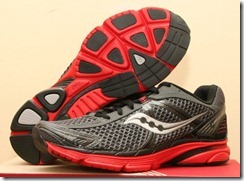 Over the past week I’ve posted reviews of two low-drop shoes from Saucony – the 5 mm drop Fastwitch 5 and the zero drop Hattori. Next up is the Saucony Mirage (disclosure – these were free media samples provided by the manufacturer). Of these three shoes, the Mirage is probably the most similar to the Saucony Kinvara, which I rated as one of my favorite shoes last year. The Mirage is clearly a product of the market success of the Kinvara (apparently the Kinvara was Saucony’s 3rd best selling shoe last year), and it targets a segment of the running community who might fear running in a soft, neutral shoe like the Kinvara (fears that I personally think are unwarranted).
Over the past week I’ve posted reviews of two low-drop shoes from Saucony – the 5 mm drop Fastwitch 5 and the zero drop Hattori. Next up is the Saucony Mirage (disclosure – these were free media samples provided by the manufacturer). Of these three shoes, the Mirage is probably the most similar to the Saucony Kinvara, which I rated as one of my favorite shoes last year. The Mirage is clearly a product of the market success of the Kinvara (apparently the Kinvara was Saucony’s 3rd best selling shoe last year), and it targets a segment of the running community who might fear running in a soft, neutral shoe like the Kinvara (fears that I personally think are unwarranted).
Appearance
The Mirage is a solid looking shoe. I have the Black/Gray/Red version, and it is definitely one of the better looking shoes in my rotation (albeit not flashy). No issues for me here.
Construction
In my opinion, the Mirage is essentially a beefed up version of the Kinvara. It has a more traditional and substantial upper, a larger heel counter, and a lot more cushioning around the ankle. The drawback of the upper is that it adds weight, but the benefit is that it should be more durable – I have seen a number of people complain about tears developing in the outer fabric of the Kinvara upper (this should be fixed by a new type of fabric in the Kinvara 2). Despite the beefier upper, the Mirage is still a fairly lightweight shoe, coming in at around 9.8oz in my size 10.
Internally, the Mirage differs from some of my other Saucony shoes in having a flat insole with no added cushion in the heel. The level of arch support is similar to the Kinvara, as is the overall fit. This is by no means a wide shoe, but it fits my average width foot pretty well.
The sole of the Mirage also feels somewhat similar to the Kinvara – they both use a relatively cushy type of EVA known as Progrid Lite. The major difference is that in the Mirage there is a small amount of medial support in the form of a curved plastic wedge underneath the arch – this can easily be seen (in black) in the image above. The added medial stability isn’t really all that noticeable to me on the run, but might make this shoe a bit less scary to those thinking about moving from stability trainers into a transitional shoe on the way to more minimalist offerings. In terms of heel-forefoot drop, the Mirage mirrors the Kinvara in being about 4 mm drop (without the insole). The one other difference when comparing the sole of the Mirage to that of the Kinvara is that there is a bit more rubber outsole on the Mirage – this may add a bit of added durability to this shoe.
Performance
I actually like running in the Mirage more than I initially thought that I would. I was concerned that the weight and stability elements would bother me, but they have not been that much of a problem. I think the fact that the sole feels very much like that of the Kinvara makes me feel at home in the Mirage, whereas the firm sole of the Saucony Fastwitch 5 was a bit of a turnoff for me (I’ve put more miles on the Kinvara than any other shoe over the past year). I’ve run as many as 15 miles in a single run in the Mirage, and have no major complaints. I probably will not be logging big miles in the Mirage going forward, mainly because I prefer less shoe, but it’s definitely a solid step in the right direction away from more traditional trainers.
Conclusion
The Saucony Mirage is a great choice as a step-down shoe for those who are looking to get out of traditional stability trainers and aren’t yet ready to take the plunge into something neutral like the Kinvara. It shares a lot of similarities with the Kinvara – similar drop, similar fit, similar feel underfoot, but is an all around beefier shoe in a number of ways. It’s also likely to be a more durable shoe than the Kinara. The Mirage would be a reasonable choice if your goal is to make a very slow transition to more minimalist offerings.
For an alternative viewpoint, check out this Saucony Mirage review by my friend Thomas at Believe in the Run.
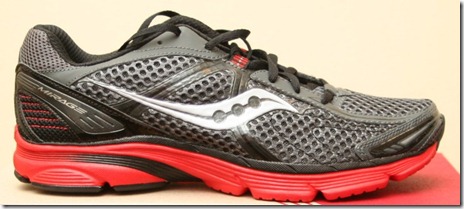
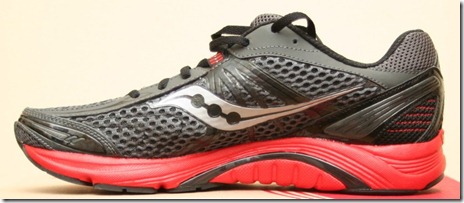
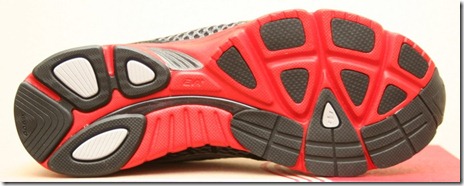
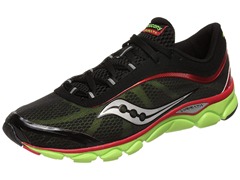
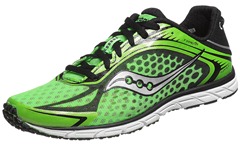

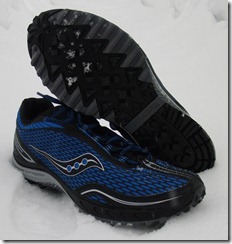
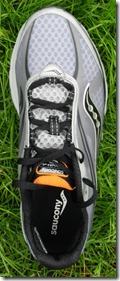














Pete,
I was wondering if you could weigh in on the current state of minimalist and transitional shoes for road running as we start to head into nicer weather here on the North coast?
Are the Merrell Trail Gloves useful for road running or better suited to actual trails? Is the Kinvara still a leading contender for on-the-road running or is there a better option with all the new offering over the last few months?
Thanks for another great review and for your input!
Chris
Chris,
I’d say that there are a lot more options out there now than ever, but
figuring out which is most appropriate for a given person is still hard. I
think it really comes down to personal preference – if you want minimal
cushion and zero drop, the Merrells, Vibrams, and Terra Plana options are my
favorite. If you want something more it gets more complicated – I still like
the Kinvara, but if I want zero drop with cushion, the Altras are good too,
as is the Saucony Hattori. I also really like the Minimus Trail, just wish
that forefoot band wasn’t such a problem. I think we’re pretty much at a
point where each runner needs to individually find their “sweet spot,” and
thankfully the variety out there know gives us a lot more leeway to do that.
Pete
Thanks Pete! I’ve got Trail Gloves and Bikila LS in the lineup already, but wanted to add something with just a bit of cushion as well for road running. Decided I’ll take the new Kinvara 2 for a spin.
Hi Pete
any thoughts on the upcoming Cortana-a built up cushioning shoe with a 4mm drop-from Saucony… am a big fan of the Kinvara because of the low 4mm drop and currently using them exclusively for training and races… am now thinking that the Cortana could be an everyday trainer…
Thanks!
Dennis
Philippines
Haven’t seen much about those yet, just what was posted on the Running
Warehouse blog.
I have just bought this shoe, indeed with the intention of making this “transition.” I tried this shoe against the Green Silence which I wish I had also bought (funds are short!!). The rep didn’t recommend the Silence based on my mileage and half marathon goals (it felt sooo nice-but it is a flat!!). He also didn’t even let me look at the Kinvara (I pressume based on the fact that I am currently may be quite neutral but a heal striker nonetheless).
Having now done a run in them they feel quite firm obviously and less responsive than some Triumph 8s I had, but a pretty quick shoe nonetheless. I therefore have some questions.
1. Is the Kinvara more responsive and flexible vis-a-vis the Mirage?
2. Does the Mirage become more responsive once fully broken in?
3. Do you think the Kinvara would cause more problems were I still transitioning to more forefoot striking? I understand the heel to toe drop is similar but is the heel bigger in the Kinvara?
4. I also didn’t really notice the medial post in the Mirage tbh. What are your thoughts on the necessity of this and is it more of a marketing tool to entice reluctant traditionalists into the market?
My conclusion: Why didn’t I try the Kinvara!!
Yes, the medial stability as I see it is to entice reluctant runners to try
something new and different. I personally don’t feel much effect of this in
the Mirage, nor do I see going into the Kinvara to be that much of a risk.
In fact, it’s a lot flatter than the Green Silence is, so not sure why you
were steered away from that one. Kinvara may be a bit more flexible than the
Mirage, and it is definitely a lot lighter. There is more than enough
cushion in the Kinvara to protect a heel striker.
Pete
Hi Pete,
Thanks for the response. The rep steered me away from the Silence because he deemed it not to be a half-marathon training shoe, which technically it isn’t, but based on what I have read it’s durability is pretty sound. I also felt when running in it, that it had enough cushioning in the right places as well should your gait lapse. What are your thoughts on this and its overall suitability for half type training as I feel very inclined to impulse buy!!?? Currently I am @ 150lbs and 5 8″.
Having now done a handful of runs in the Mirage including some pyramid interval training 6.40 pace (just short of 7 miles in total mostly grass), I like this shoe. The lightness compared to my previous stability shoe is phenomenal and does make you want to go fast. I do feel closer to the ground and I do feel more efficient. I really don’t have an issue with the heel to toe drop and all that work on my calves and hamstrings+ core seems to mean I can transition quite easily. I also feel that my foot is being allowed enough room to move correctly within the shoe and I still cannot feel this medial post except when you first put it on.
Ultimately, the research I have done and the experience of this shoe, already means I want to go lower and lighter. Just the amount of choice available to me now is so much wider than I had previously thought. I think I will become addicted as well!! I fancy trying the Kinvara, the New Balance Minimus and the concept of the Altra. I especially fancy the Minimus. How would you compare it to the Kinvara and Mirage?
Thanks
Andy
Hello Pete,
I wrote to you a while back that you are really inspiring and your fight for minimalistic running makes one more eager to go that path. Since my funds are not that big when it comes to shoes, I try to wait for discounts and other offers to buy my shoes. At one store I got a 25% discount voucher so I went there to get the Adidas adios or aegis 2 as I have tried them before but none of them had my size. I saw then the Saucony Mirage and I have been running lately with Saucony Guide 4 which I like. However, I want to run with lightweight shoes, I want to run with zero drop and I want to run marathons with such shoes. The price of the MIrage was extremely encouraging to buy them and on the treadmill they felt really nice.
Then was the decision to either buy them or not and so was the only way to do that is read your review. I am a bit worried to going to shoes that totally lack support even though you say that this fear is unwarranted. Your review on these shoes was anyway exactly what I wanted to read to buy the shoes. And now a few hours after the purchase, I am sitting at home with the shoes in my feet and enjoying how comfy they are. What is needed is to go for a small run outside to know exactly what I got but I can imagine the feeling and the experience will have to wait for tomorrow.
How do you compare these shoes to the Adidas I mentioned? And above all how do they compare them to Nike Free?
The Mirage is a great choice for a step down from the Guide. They
still have plenty of cushion and a bit of stability, but the heel is
dropped to around 4-5mm. I haven’t worn the Adidas, so can’t comment
on those, but the Mirages are a bit more shoe than the Frees, and the
latter are also much more flexible. The Mirage is basically a
traditional style stability shoe with about 1/3 of the heel lift.
Don’t think you will have too much trouble moving into them.
Enjoy!
Pete
Hi Pete,
I’ve been running with the Asics GT 2160s but recently switched to the Mirage and they feel great. As an inexperienced runner I wanted to learn if the Mirage is enough shoe for an upcoming marathon (1st) or should I stick with a beefier shoe like the Asics for the marathon?
Thanks
If you’re not having any problems with them on long runs, I think
they’d be fine in a marathon.
Hi Pete
I am onto my second pair of Kinvaras (just bought the Kinvara 2s). I love the flexibility and midfoot cushioning (am a midfoot striker) and the ride is so very plush!
I am a lightweight at 60kgs but I do land on the blade of my foot where no lugs cover the EVA, so they wear quickly. I have used my Kinvara2s for a 5km and for my first marathon, and they have already started to shoe signs of wear.
I am thinking of buying a pair of Mirage’s for training and saving the Kinvaras for races. I have tried on the Mirage’s and they feel pretty close to the Kinvara’s but they look like they are more durable. Otherwise back to my Lunar Racers.
You may get a bit more mileage out of the Mirage, hard to say for sure. Surprised the Lunar Racers work as there is not a lot of rubber on those either.
Thanks. I think it is as much as where the high wearing rubber is placed. In the Kinvaras it is missing from where it needs to be for me. I was thinking of applying some shoe goo. Are there any comparable shoes to thr Kinvara that you can recommend (Brooks Green Silence)? I love the midfoot cushioning.
The Green Silence is soft like the Kinvara, so that might work for you.
Hi Pete,
I love reading your blogs. I seem to get injured most years, so I’m trying to go for more minimal shoes. I started with the Newton sir Isaacs, but I wasn’t that keen on the lugs – felt quite hard and strangely hurt the top of my feet… I thought about the Nike Run+, but on the treadmill it showed that my feet rolled in too much, so not quite ready for these. I then tried the Kinvara’s. They felt great and not much inward roll. My only fear is whether I should have gone for the Mirage – I couldn’t try these as they didn’t have them in the UK at the time (we are always several months behind America…) The inside of my ankle is sometimes quite sore in the mornings. It even looks like its swelling very slightly. I’m wondering whether its because the Kinvara has little support on the ankle section and I gradually roll more towards the end of the run. Do you think the Mirage would provide more support? I’m struggling to find a retailer in the UK for these – I can only find on-line stores. If I do go for these, is the sizing the same as the Kinvara – always a gamble when buying on-line.
Thanks, Joe
Hi Pete – long time reader and big fan of your blog. I started my transition to minimalism with a couple pairs of Kinvaras but then bought the Mirages at the suggestion of a physical therapist who thought I needed just a touch of stability. I like the feel of Mirage sole better than the too-soft Kinvara, but like you I feel like the upper is just too much shoe. Have you come across any shoes with the Mirage-ish sole feel with the minimal upper and small heel-toe drop?
Thanks again for the great material here.
Jeremy
Jeremy – you may want to check out the inov8 Road X line. I just bought a
pair of the Road X 233 and liking them so far. Similar drop to the Kinvara,
roomier forefoot, but firmer.
Thanks for the reply, Pete – I’ll definitely check ’em out.
Thanks for the review. Bought the Mirage yesterday and had a good run in them today. They’re firmer than the Kinvara’s but a nice balance with the Saucony Tangent’s. Saucony’s seem to fit my feet better than other brands.
I like the mirage. It is a very comfortable feel, with a little more support than the Kinvara. It would be great for work where I am on my feet all day. The toe box is a little narrow, though. Do you know of a shoe with similar structure, but with a wider toebox?
You may want to check out the inov-8 RoadX 233 or the NB Minimus Road. Both
have a wider toebox, but are a bit firmer than the Mirage.
Just had my first run in the Mirage after running with the Kinvara 2 over the past couple months. Really enjoy the little bit of extra stability and ride the Mirage has. I’m training for my first 1/2 marathon and it’s been a great shoe for me to do long runs. I still love the Kinvara’s for my faster pace workouts.
Thanks for the review.
What is the heel-toe drop with the insole on the Mirages?
4mm drop, can’t recall if the insole was flat in that shoe.
I have always worn cushioned neutral shoes. I tried a pair of Merrill minimalist shoes and they were too hard on my legs. I then tried Karhu Fast Fulcrum. That were even worse. So today I go to buy a pair of shoes and they recommend the Saucony Mirage. But reading the reviews it looks like another minimalist type shoe. I think I need more cushion. Will this shoe give me that ? Thanks
It’s really only minimalist in that it has a low differential between the heel and forefoot heights. Plenty of cushion in the Mirage.
Thanks. Am trying them tomorrow !
Hi Pete, I have only just come across this blog and wanted to ask your opinion about switching from Saucony Guide 5/6 to the Mirage instead.
I over-pronate but I suspect not as much as I use to, I have incorporated weight training and core training into my runs, I also swim and bike (Triathlon lover now). Are these shoes suited for someone over 84 kilos (185 lbs)? I really do feel like a stronger runner, I also have orthortics, so am I able to switch you think?
I am no longer a heel striker, more a mid foot striker.
The low heel drop sounds appealing to me.
Any help would be appreciated.
IT’s a pretty mild step down, if you take a gradual transition from one shoe to the other you shouldn’t have too much trouble I don’t think. Maybe some calf soreness due to the lower drop initially. Probably fine to mix the two shoes on different days at first.
—-
Pete Larson’s Web Links:
-Performance Health Spine and Sport Therapy<http: about-us=”” dr-peter-larson=”” performancehealthnh.com=””>
-My book: Tread Lightly: link to ow.ly
-Blog: https://runblogger.com
-Twitter: link to twitter.com
-Facebook Page: link to facebook.com…
-Discussion Forum: https://runblogger.com/forum</http:>
Thanks Pete, good to know, always good to check about the weight, not all runners are 70 kilo gazelles ;o)